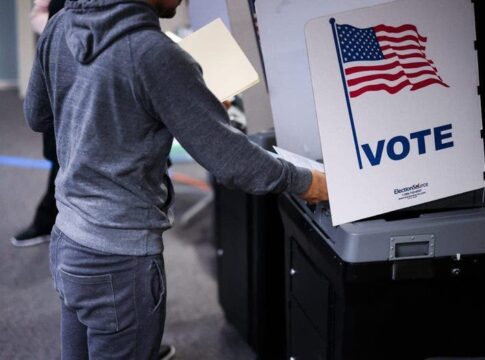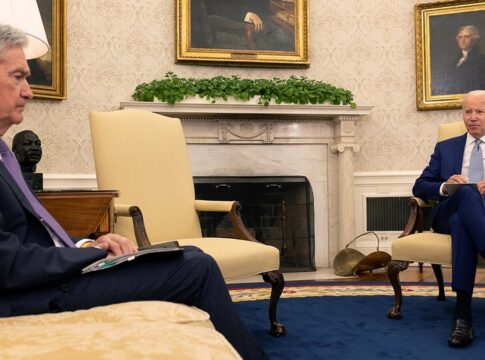An icon in the shape of an angle pointing down.
Michael Brochstein/SOPA Images/LightRocket via Getty Images
- Portland’s Made in Old Town project aims to make a stateside manufacturing hub for sports-apparel makers.
- Its backers Hilos and the Technology Association of Oregon hope to generate 6,000 jobs as soon as 2028.
- This article is part of “The Future of Supply-Chain Management,” a series on companies’ manufacturing and distribution strategies.
The Northeast is the ancestral home of footwear manufacturing in the US, where New Balance still assembles more than 4 million pairs of sneakers each year.
But much of the industry resides in Portland, Oregon, and its surrounding suburbs, home to well-known brands such as Nike, Columbia Sportswear, Keen, and the North American branch of Adidas. At least a dozen apparel companies, including Lululemon and Allbirds, have part of their operations stationed in the city.
Despite Portland’s ties to the footwear and sports-apparel industries, it isn’t typically considered a manufacturing hub. But that could soon change with a plan for a $125 million development campus called Made in Old Town. The project aims to bring footwear and apparel manufacturing to the industry’s largest US design and product development hub by transforming four city blocks into 323,000 square feet of office space, sample rooms, apparel-manufacturing machines, retail space, and housing.
Backers of the project — including the startup Hilos and nonprofits like the Technology Association of Oregon — envision millions being reinvested in vacant and underused properties in Portland’s Old Town neighborhood. The infrastructure would be available for rent to the region’s roughly 300 sportswear brands, which could pay a monthly fee to use the various spaces for their production needs instead of relying on their typical overseas collaborations with Asian manufacturers.
The hope is that if more manufacturing capabilities are brought to the Portland region, brands can more quickly churn out designs for footwear and apparel, according to project backers. And faster production means brands can stay abreast of quick-to-change trends, in terms of both fashion and functionality, to turn greater profits in a highly competitive industry.
Relying on Asian manufacturing for footwear production has its challenges
Nearly all shoes sold in the US are made abroad, mostly in Asian countries including Vietnam and China. The shift to manufacturing primarily in Asia was largely driven by major brands looking to reduce their manufacturing costs. For instance, Nike moved its manufacturing to China in the early 1980s.
Indeed, taking manufacturing overseas did lower costs, but this decadeslong shift also resulted in a decline in the total number of US footwear-manufacturing jobs. In 1990, there were an estimated 76,000 domestic jobs, compared with a little over 11,000 today, according to data from the Bureau of Labor Statistics.
“Factory owners and suppliers need to be globally competitive in manufacturing and need to be able to be closer to brands,” Elias Stahl, the CEO of Portland’s Hilos, told Business Insider.
With Hilos, a startup that sells software to make it easier for footwear brands to make their gear through 3D printing, Stahl has become a major backer of the Made in Old Town effort, including by recruiting former Nike and Adidas executives to serve on the project’s board.
In addition to creating jobs, Made in Old Town backers hope to help speed up the manufacturing process for smaller brands. Apparel-design teams are largely in the US, so new designs for sneakers and shirts are typically created an ocean away from the plants where they’re later produced. But if more manufacturing infrastructure was stateside, it could aid in shoe-design rollouts, said Eric Liedtke, a former Adidas executive and the CEO and a cofounder of Unless, which makes plant-based footwear and apparel.
According to Liedtke, who’s a Made in Old Town board member, startups would benefit from Made in Old Town if the space could bring together designers, manufacturers, and materials suppliers as intended. Today, many apparel brands’ in-house US designers, engineers, and product marketers have to do multiple rounds of product-design development. They also have to make multiple trips to factories in Asia to complete in-person prototyping, which involves making a physical model of a shoe to experiment with its design, shape, and materials before settling on the final product.
To get around this back-and-forth, larger brands like Nike and Adidas have already created their own stateside sample rooms — spaces where prototypes of shoes and other sports gear are made — to consider design and material selections. They’ve also invested in digital tools to smooth the flow of information between their design teams in the US and manufacturing facilities abroad.
Smaller brands could also save a lot of time and money if those same resources, including 3D-printing capabilities and more in-person interfacing with materials suppliers, were brought closer to home, Liedtke said.
The sportswear industry is facing turbulent times
The legacy sportswear players have struggled recently amid greater competition from upstarts like Alo Yoga, Vuori, and Hoka. Nike has posted soft sales and told investors that a turnaround plan will take at least a few quarters.
Earlier this year, Adidas, based in Germany, reported its first annual loss in over 30 years as it posted a 16% sales drop in North America. And Under Armour has posted soft sales for several years, which has punished the company’s stock.
The upheaval in the sports-apparel and footwear business has greatly affected the Portland region, where Nike is based and brands like Adidas, Lululemon, Deckers Brands, and Under Armour have a large presence. Nike and Columbia Sportswear are among the major employers in the area that have announced layoffs due to the industry’s shifting fortunes.
At the federal level, the US government has offered billions in subsidies to support manufacturing, mostly targeting the auto, semiconductor, and solar industries. In recent years, this has helped add hundreds of thousands of jobs in manufacturing.
This approach tends to focus on industries deemed vital for national security but lets industries like apparel fall by the wayside, Stahl said. But with some state- and private-industry funding, the sportswear industry could be revitalized in Portland and beyond, Stahl added.
With the Made in Old Town project, the aim is to generate about 6,000 full-time jobs in Portland by as soon as 2028.
Lessons learned from Adidas’ Speedfactory flop
When Liedtke worked at Adidas, he spearheaded an effort to reroute footwear manufacturing to local markets and closer to the shoppers buying the brand’s sneakers to boost innovation and sales.
Adidas opened two automated manufacturing facilities, called Speedfactories, in Atlanta and Germany, but both closed within just a couple of years. “We gave it our best effort. It just didn’t work out,” Liedtke told BI.
He said the model was partly flawed because the technology could not account for quickly changing fashion trends. Only one shape of footwear could be created at a time, limiting production efforts.
Liedtke said the Adidas Speedfactory flop taught him the importance of getting support from materials suppliers. For example, if materials suppliers are incentivized to set up their sampling and prototyping equipment in Portland, brands there can work through the early stages of footwear design and production more quickly. This approach would make them similar to automakers in the US, who can still make their cars and trucks stateside because many auto-parts suppliers have stationed themselves in the Midwest.
Right now, the plan is to dedicate about half of the Made in Old Town space’s square footage to sampling and prototyping machinery and 3D printers. As for replacing manufacturing abroad altogether: “That’s way down the road,” Liedtke said.
A long way to go
The Made in Old Town project is still in its early stages, having raised $15 million of its $125 million goal. Oregon lawmakers have set aside just $2 million to support Made in Old Town after Gov. Tina Kotek approved the funding in April.
No brands have publicly disclosed their interest in joining the campus or made any financial investments to support Made in Old Town, and the initiative’s backers say an additional $120 million will be needed from brands, suppliers, and manufacturers to support investments in local talent and equipment.
For 2024, the focus is on creating a system that can support startup-size brands who want to speed up their footwear-design and -manufacturing processes, Noel Kinder, Nike’s former chief sustainability officer and a member of the Made in Old Town board, said.
“The vision is to accelerate the pace of innovation,” Kinder said. “The intention is not to replace the hundreds of millions of pairs of shoes that are made all over the world.”



